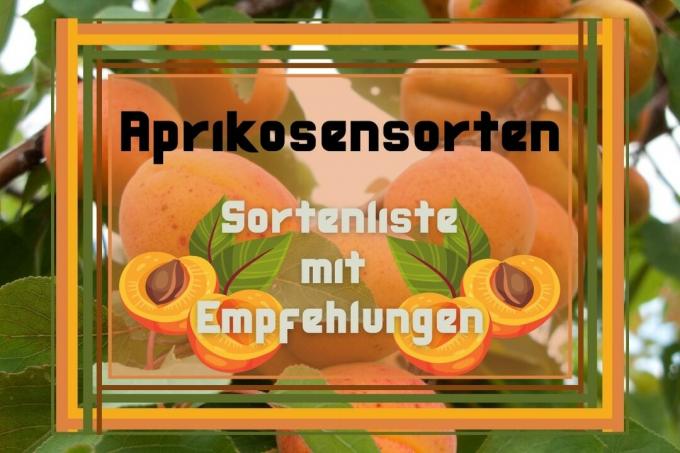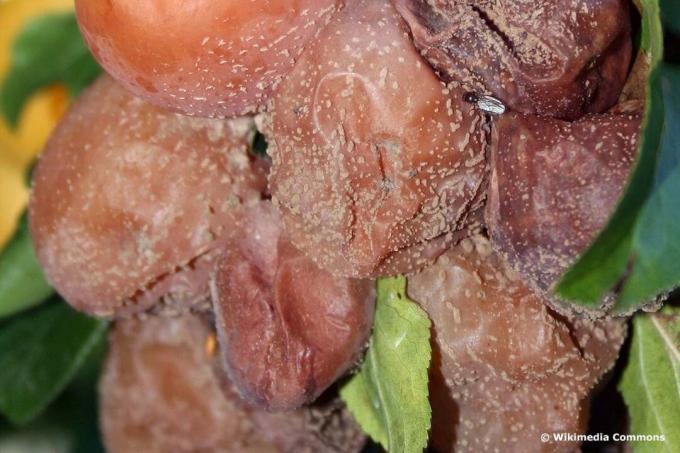
table of contents
- Recommended varieties: Top 4
- Other recommended varieties from A to G
- H to L
- M to Z
- Not recommended varieties
- frequently asked Questions
In the past, apricot trees were considered sensitive and cultivation in Central Europe was usually not worthwhile. Today there are breeds that produce recommendable apricot varieties and are described in more detail below.
In a nutshell
- many apricot varieties with lower susceptibility to disease and sensitivity to cold
- Cultivation possible in Central European climate
- warm, sunny and breathable location is fundamentally important
Recommended varieties: Top 4
The top 4 among the recommended apricot varieties convince with their high resistance to Diseases on apricot trees, low sensitivity to frost and, in addition, abundant crop yields.

Compacta (Prunus armeniaca "Compacta")
- Growth: compact; weak growing; up to two meters in height
- Fruits: orange; medium-sized; medium soft; very juicy and aromatic; easily loosening stones
- Harvest time: mid / late July to August
- Location: sun to partial shade
- Particularities: Monilinia resistance; hardy to minus 25 degrees Celsius; self-fruiting
Harlayne (Prunus armeniaca "Harlayne")
- Growth: upright; broad crown; between two and three meters in height
- Fruits: orange-yellow; small to medium in size; fixed; sweet aroma
- Harvest time: mid-late from the end of July to the end of August
- Location: Sun - sheltered from the wind in late frost
- Special features: robust; undemanding; abundant crop yield; hardy; self-fruiting apricot variety
Kyoto (Prunus armeniaca "Kioto")
- Growth: upright; weak; between three and four meters in height
- Fruits: initially golden yellow, later orange-red; medium-sized; around; fixed; sweet aroma with a slightly sour note
- Harvest time: mid-July to early August
- Location: sun to partial shade
- Special features: low frost losses due to late flowering; further apricot trees promote crop yield; must be thinned out regularly; very hardy
Kuresia (Prunus armeniaca "Kuresia")
- Growth: strong; powerful; broad crown; between three and four meters in height
- Fruits: medium-sized; orange-yellow to red; oval; firm pulp; Sweet and sour taste
- Harvest time: late July to mid-August
- Location: sun to partial shade
- Special features: very robust and hardy, therefore also suitable for colder regions; only apricot variety with Sharka resistance
tip: You can't go wrong with the top 4 apricot varieties mentioned. They are the best choice if you want to be on the safe side, although other varieties are also recommended.
Other recommended varieties from A to G
Ambrosia (Prunus armeniaca "Ambrosia")
- Growth: strong; semi upright to spread out; well branched; aged up to seven meters in height
- Fruits: large; orange; smooth-skinned; easily stone-soluble; very juicy pulp; Taste sweet, low acidity; intense aroma
- Harvest time: early to mid-July
- Location: sun to partial shade
- Special features: higher crop yields through pollination of other varieties; shoots sensitive to frost
Bergeron (Prunus armeniaca "Bergeron")
- Growth: medium strong; upright; Height between four and five meters
- Fruits: large; rounded oval; greenish-yellow to orange-yellow; juicy; medium firm with soft skin; sweet taste
- Harvest time: beginning to end of August
- Location: sun to partial shade; in a protected southern or western location
- Special features: self-fruiting

Golden Sun (Prunus armeniaca "Golden Sun")
- Growth: columnar; upright; Height between 200 and 250 centimeters
- Fruits: large; up to 60 grams in weight; juicy; bright orange; Very sweet taste
- Harvest time: July
- Location: sun to partial shade
- Special features: self-fertile; robust; Columnar plant; well tolerated by cutting; hardy; year-round planting time
Gold Rich (Prunus armeniaca "Gold Rich")
- Growth: upright; weak; Height between 200 and 400 centimeters
- Fruits: medium-sized; juicy; yellow-orange-red; sweet taste
- Harvest time: late; August to September
- Location: full sun to partial shade
- Special features: self-pollinating; insensitive to diseases and frost; easy-care; medium crop yields
H to L
The first ripe fruits can be harvested in summer. This means that the fruits are picked one by one and never the whole tree is harvested at the same time.

Hargrand (Prunus armeniaca "Hargrand")
- Growth: strong; broad crown; compact; Height between 300 and 400 centimeters
- Fruits: up to eight centimeters in size; orange-yellow; fixed; light stone solution; Very sweet and sour taste
- Harvest time: late July to early August
- Location: sun
- Special features: less susceptible to diseases and less sensitive to late frosts; self-pollinating; Standard apricot variety in commercial cultivation; high crop yield
Note: Apricot varieties that do not require cross-pollination by other specimens for fruiting are called self-fruiting. Sometimes, however, self-pollinators show low yields, which can be increased by neighboring cross-pollinators.
Harogem (Prunus armeniaca "Harogem")
- Growth: strong; upright; Height between 300 and 400 centimeters
- Fruits: very large; golden yellow with orange-red sunny side; firm but very juicy pulp; very cute
- Harvest time: late July to early August
- Location: sun
- Special features: needs a protected location; hardy; insect friendly; Bloom endangered by late frost
Hilde (Prunus armeniaca "Hilde")
- Growth: medium strong; thin shoots; spherical, broad crown; overhanging growth; compact; Height between 300 and 400 centimeters
- Fruits: large to very large; little felty hair; medium firm, juicy pulp; subtly sweet
- Harvest time: mid-July to mid-August
- Location: sun to partial shade
- Special features: self-fertile; hardy; Insensitivity to sharka; moderately susceptible to Monilla; low risk of space
Iziagat (Prunus armeniaca "Iziagat")
- Growth: semi-upright; medium to strong growth; Growth height up to 350 centimeters
- Fruits: medium-sized; almost complete purple body color; medium firm; sweetly aromatic
- Harvest time: mid to late July
- Location: sun to partial shade
- Special features: new apricot variety from France; frost resistant; insect friendly; self-fertile; burst-proof; high crop yields
Luizet (Prunus armeniaca "Luizet")
- Growth: strong; broad crown; compact; Growth height up to ten meters
- Fruits: medium-sized; around; juicy; golden yellow; Taste sweet
- Harvest time: late July to mid-August
- Location: full sun; sunny
- Special features: low maintenance requirement; hardy to at least minus 15 degrees Celsius; medium high yields; ideal for rough growing areas

M to Z
Mombacher (Prunus armeniaca "Mombacher")
- Growth: broad and bushy; loose structure; Height between 300 and 450 centimeters
- Fruits: smaller; yellow with red dots on the sunny side; juicy, tender, medium-firm pulp; Taste sweet, aromatic
- Harvest time: July to August
- Location: sun to partial shade
- Special features: productive; self-fertile; robust and old variety of apricots; chalk-loving
Nancy (Prunus armeniaca "Nancy")
- Growth: upright; tree-like; loose crown; Height between 300 and 500 centimeters
- Fruits: medium-sized; yellow; juicy; around; sweet, aromatic taste
- Harvest time: late July to early August
- Location: sun; sheltered from the wind
- Special features: good frost resistance; very productive; undemanding; flowers sensitive to cold
Orangered (Prunus armeniaca "Orangered")
- Growth: bushy; medium to strong; well branched; Growth height up to 350 centimeters
- Fruits: large; orange with dark red sunny side; firm pulp; very tastefull; subtle sweetness
- Harvest time: mid to late July; in optimal weather conditions from the beginning of July
- Location: sun to partial shade
- Special features: low yields with self-fertilization, therefore additional pollinating plants are advisable; hardy; known for excellent food quality; is also called giant apricot

Temporao de Villa Franca (Prunus armeniaca "Temporao de Villa Franca")
- Growth: strong; upright; Growth height up to 450 centimeters
- Fruits: medium-sized; bright orange-yellow; fixed; juicy; sweet and sour aroma
- Harvest time: mid to late July
- Location: sun to partial shade
- Special features: self-fertile; should always be protected, albeit hardy
Hungarian best (Prunus armeniaca "Hungarian best")
- Growth: strong; powerful; between three and five meters in height
- Fruits: medium-sized, orange-yellow with red speckles; juicy, firm pulp; Sweet and sour taste
- Harvest time: mid-July to early August
- Location: sun to partial shade
- Special features: tried and tested and popular variety; Flowering late frost endangered; otherwise hardy
Dwarf apricot "Little Lena" (Prunus armeniaca "Little Lena")
- Growth: upright, compact, dwarf-shaped; Growth height up to 150 centimeters
- Fruits: yellow-orange; roundish; fixed; sweet and sour
- Harvest time: August to September
- Location: sun
- Special features: ideal for keeping pots; self-fruiting; pronounced Mediterranean flair; well hardy; Frost-free overwintering is advisable if kept in a bucket
Dwarf apricot "Rosina" (Prunus armeniaca "Rosina")
- Growth: weak; Dwarf form; Height between 100 and 120 centimeters
- Fruits: yellow-orange-red; medium-sized; spicy aromatic
- Harvest time: August to September
- Location: sun to partial shade
- Special features: ideal for keeping pots; well hardy; frost-free overwintering is advisable if kept in a bucket; rare and protected variety
Not recommended varieties
Apricot varieties that are not recommended include those that are highly susceptible to fungal diseases and pests. A relatively high sensitivity to frost also ensures low to no crop yields and, in the worst case, can ensure a very short lifespan for the apricot trees. For the reasons mentioned and because there are enough recommended varieties, it is not advisable to grow these varieties yourself. Here are a few examples of non-recommended apricot trees:
- Delice cot.: high lack of space; high risk of monilinia
- Mino: very susceptible to all types of mushrooms
- Wonder cot.: very susceptible to monilinia and rain spots

frequently asked Questions
There are no differences. Apricots are called apricots in Austria. The term also occurs occasionally in Germany. But it is the same type of fruit.
This variety is not directly related to mirabelle plums or apricots. They just belong to them Stone fruit-Growths on. The "Aprimira" was bred in 1994, but nothing more can be learned about it. Because it is visually similar to both species, it is called mirabelle apricot, but actually falls under the plums.
Apricot varieties that have positive properties should be selected as cross-pollinators. This mainly concerns the susceptibility to diseases and monilla. But taste also plays an important role: if you want to harvest purely sweet fruits, the pollinator should be able to produce sweet fruits itself. It is important that both varieties complement each other optimally.



